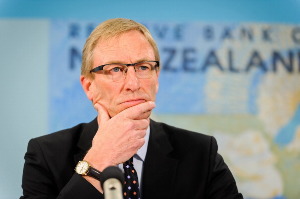Inflation problem for RBNZ
If inflation doesn’t pick up by late 2018 interest rate cuts could again be on the cards, according to the Reserve Bank.
Tuesday, December 5th 2017, 2:39PM
by Miriam Bell

Speaking to the Institute of Directors in Auckland today, Reserve Bank acting governor Grant Spencer noted that inflation is forecast to pick up from late 2018 due to increasing capacity pressures.
“If this response does not eventuate then we would have to consider a further easing of policy to generate additional domestic demand pressure, particularly if global inflation remains low in line with our forecasts.
“However, we would need to be careful not to generate unwarranted instability in output, the exchange rate or indeed household debt.”
In essence this means that rather than seeing hikes to the OCR next year, as is generally expected, further OCR cuts could be on the cards instead – if inflation remains weak.
The OCR is already sitting at a record low of 1.75% and economists do expect it to stay put for some time.
But persistently low inflation has long been a concern for the Reserve Bank and it has prompted the bank to consider whether it needs to tweak its monetary policy approach.
Spencer says global trends like globalisation, the growth of China, the rise of the digital economy, and low inflation expectations appear to be changing the nature of the price formation process in New Zealand.
In turn, these factors may be reducing the leverage monetary policy has over inflation, although their persistence and impact on inflation in New Zealand remain uncertain.
Monetary policy has less than fully offset the weakness in imported inflation which was not expected to be so persistent and has been overlaid with uncertain commodity price movements, he says.
“The on-going shock has resulted in CPI inflation running below the 2% target mid-point. The policy response has been consistent with our flexible inflation targeting framework.
“More recently we have been assuming greater persistence in low global inflation and this is contributing to our current flat track for future OCR levels.”
The situation has caused the Reserve Bank’s flexible inflation targeting approach to become more flexible.
Further, Spencer says that, in a bid to meet their long term price stability objective, relatively more weight is being attached to output, employment and financial stability.
“However, this can only be sustained if monetary policy’s long term price stability credentials are maintained.”
For ASB chief economist Nick Tuffley, one of the key points of Spencer’s speech was that the Reserve Bank needs to be flexible and patient in its actions to get inflation back to around 2%.
“That balances against being too rigid in driving inflation back to target, and embraces the avoidance of unnecessary economic volatility.”
They note Spencer’s comment that the Reserve Bank will “have to consider” further easing if the global inflation backdrop remains weak.
But they say it will take time for uncertainties around the key inflation drivers to become more apparent.
“Meanwhile the Reserve Bank has plenty of time – we continue to see the RBNZ remaining on hold until early 2019.”
| « LVR changes won’t prompt market frenzy | Vincent Capital adds a South Island BDM » |
Special Offers
Comments from our readers
No comments yet
Sign In to add your comment
| Printable version | Email to a friend |



